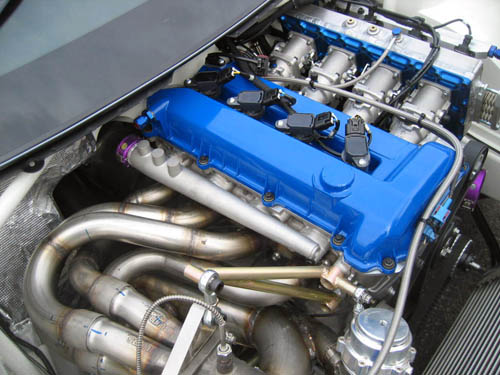Keeping a cool head
 There is no doubt about it, the engine in your average family saloon car has come on a long way in the last 30 years. When once we struggled to get 100 bhp out of a 1.6 litre engine, today 100 bhp per litre is now easily achievable. Such are the improvements to the humblest of engines, the latest 1.6 litre Duratec although rated at 100PS (98.6 bhp) in the Ford Fiesta produces the thick end of 160 with only slight changes to the cam and induction / exhaust system. But for 200 bhp per litre it’s a different matter.
There is no doubt about it, the engine in your average family saloon car has come on a long way in the last 30 years. When once we struggled to get 100 bhp out of a 1.6 litre engine, today 100 bhp per litre is now easily achievable. Such are the improvements to the humblest of engines, the latest 1.6 litre Duratec although rated at 100PS (98.6 bhp) in the Ford Fiesta produces the thick end of 160 with only slight changes to the cam and induction / exhaust system. But for 200 bhp per litre it’s a different matter.
At those sorts of power outputs, the amounts needed to be competitive in Division One of the European Rallycross championship, even the best-designed production car engine would begin to feel the strain. At 600+ bhp, the production cylinder head on any turbocharged 2.0 litre engine would be bound to struggle and so the only sensible way around the problem might be to design your own. But setting aside all the other issues of porting and cam drives, at these power levels, cooling, particularly in the cylinder head itself, is a big issue.
Cylinder heads like that of the OE production Duratec need to have a low thermal mass with minimal cooling around the exhaust ports. Strict exhaust emission standards worldwide today mean that engines need to warm up extremely quickly and all subsequent waste heat has to be retained in the exhaust gas and directed towards the exhaust catalyst. To pass exhaust emission legislation, this needs to reach ‘light-off’ temperature within 20 seconds of ‘key-on’ and so for rapid warm up, coolant volumes will need to be very small with minimal cooling around the exhaust ports.
For competition engines, however, with long periods of running at wide open throttle, the overall amount of cooling will need to be much greater and so while overall coolant volumes won’t necessarily need to increase much, the coolant may need to be redirected to the more critical areas, such as the exhaust valve seat or where excessive temperatures can destroy some of the heat treated properties of the aluminium itself. At the same time the coolant flow rate needs to be balanced out to ensure even temperatures around and across the coolant cores and hence minimise any temperature-induced strain.

In optimizing this coolant flow, the designer also has to ensure that high flow velocities and rapid changes of cross-section don’t coincide with high heat flux zones. I remember one engine with this design flaw, which proceeded to erode the internal cooling jacket zone through cavitation in a matter of hours. In this particular case, the cylinder head (which was designed to use only minimal amounts of coolant flowing across the head) introduced a region of low static pressure just where the heat flux was greatest. The high coolant velocity at this point of low pressure, caused instantaneous boiling of the coolant and the sudden energy released eroded the wall of the coolant jacket just above the combustion chamber creating a nice little hole into the combustion chamber by the time the engine was just becoming run-in.
Stagnant flow areas can also lead to similar problems and so to address this problem and minimise any build up of any entrained air/steam, some form of internal or external water rail above the exhaust ports might be advisable. By carefully pumping the coolant along and across the cylinder head not only does this reduce the mechanical stresses but is also likely to reduce the possibility of the rearward cylinder running hotter than the others and running into detonation.
At 600+ BHP getting the air into the engine and the power out is one set of problems. Ensuring that the cylinder head simply doesn’t melt into sort kind of amorphous mass is quite another...
Written by John Coxon.